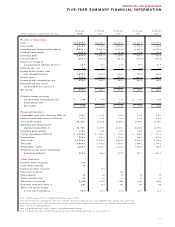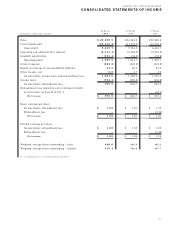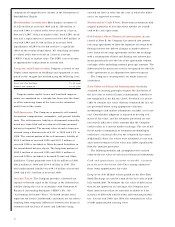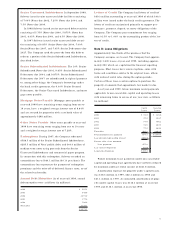Safeway 1999 Annual Report Download - page 29
Download and view the complete annual report
Please find page 29 of the 1999 Safeway annual report below. You can navigate through the pages in the report by either clicking on the pages listed below, or by using the keyword search tool below to find specific information within the annual report.
27
SAFEWAY INC. AND SUBSIDIARIES
NOTES TO CONSOLIDATED FINANCIAL STATEM ENTS
Note A: The Company and Significant
Accounting Policies
The Company Safeway Inc. (“Safeway” or the
“Company”) is one of the largest food and drug chains in
North America, with 1,659 stores as of year-end 1999.
Safeway’s U.S. retail operating areas are located principally
in northern California, southern California, Oregon,
Washington, Alaska, Colorado, Arizona, Texas, the
Chicago metropolitan area and the Mid-Atlantic region.
The Company’s Canadian retail operations are located
principally in British Columbia, Alberta and
Manitoba/Saskatchewan. In support of its retail operations,
the Company has an extensive network of distribution,
manufacturing and food processing facilities.
As discussed in Note B, in September 1999 the
Company acquired all of the outstanding shares of
Randall’s Food Markets, Inc. (“Randall’s”) in exchange
for $1.3 billion consisting of $754 million of cash and
12.7 million shares of Safeway stock (the “Randall’s
Acquisition”). The acquisition was accounted for as a pur-
chase and Randall’s operating results have been consoli-
dated with Safeway’s since the beginning of the fourth
quarter of 1999.
Also discussed in Note B, in April 1999 Safeway com-
pleted its acquisition of all of the outstanding shares of
Carr-Gottstein Foods Co. (“Carrs”) for approximately
$106 million in cash (the “Carrs Acquisition”). The Carrs
acquisition was accounted for as a purchase. Safeway’s
1999 income statement includes 40 weeks of Carrs’
operating results.
In November 1998 the Company acquired Dominick’s
Supermarkets, Inc. (“Dominick’s”), by purchasing all of the
outstanding shares of Dominick’s for a total of approxi-
mately $1.2 billion in cash (the “Dominick’s Acquisition”).
The Dominick’s Acquisition was accounted for as a pur-
chase. Dominick’s operating results have been consolidat-
ed with Safeway’s since approximately midway through the
fourth quarter of 1998.
In April 1997 Safeway completed a merger with The
Vons Companies, Inc. (“Vons”) pursuant to which the
Company issued 83.2 million shares of Safeway common
stock for all of the shares of Vons common stock that it
did not already own for an aggregate purchase price of
$1.4 billion (the “Vons Merger”). The Vons Merger was
accounted for as a purchase. Beginning in the second
quarter of 1997, Safeway’s consolidated financial state-
ments include Vons’ financial results.
In addition to these operations, the Company has a 49%
ownership interest in Casa Ley, S.A. de C.V. (“Casa Ley”),
which operates 86 food and general merchandise stores in
western Mexico.
Basis of Consolidation The consolidated financial
statements include Safeway Inc., a Delaware corporation,
and all majority-owned subsidiaries. All significant inter-
company transactions and balances have been eliminated
in consolidation. The Company’s investment in Casa Ley is
reported using the equity method. Prior to the Vons Merger
in the second quarter of 1997, the Company’s investment
in Vons was reported using the equity method.
Fiscal Year The Company’s fiscal year ends on the
Saturday nearest December 31. The last three fiscal years
consist of the 52-week period ending January 1, 2000, the
52-week period ended January 2, 1999 and the 53-week
period ended January 3, 1998.
Revenue Recognition Revenue is recognized at the
point of sale for retail sales. Vendor allowances and credits
that relate to the Company’s buying and merchandising
activities are recognized as earned.
Use of Estimates The preparation of financial state-
ments in conformity with generally accepted accounting
principles requires management to make estimates and
assumptions that affect the reported amounts of assets and
liabilities and disclosure of contingent assets and liabili-
ties at the date of the financial statements, and the report-
ed amounts of revenues and expenses during the reporting
period. Actual results could differ from those estimates.
Translation of Foreign Currencies Assets and
liabilities of the Company’s Canadian subsidiaries and
Casa Ley are translated into U.S. dollars at year-end rates
of exchange, and income and expenses are translated at
average rates during the year. Adjustments resulting
from translating financial statements into U.S. dollars are
reported, net of applicable income taxes, as a separate
























